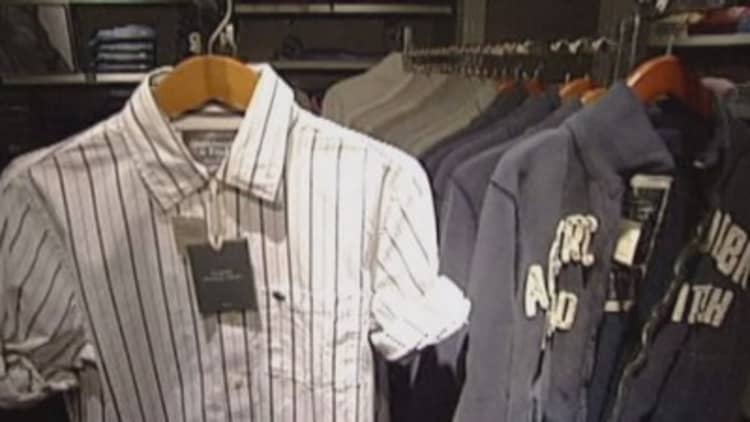Fickle teenagers are pushing back against the specialty stores that cater to them, leaving basics, hoodies and polos as casualties in the aftermath.
But this braces-wielding demographic isn't the only group leaving teen retailers behind.
According to experts, parents and the purchasing power they represent are also shying away from Abercrombie & Fitch, Aeropostale and American Eagle—often referred to as the three As—as they seek value when making purchases for their teens, whose participation in the working world remains low.
"With increasing value there is increasing purchase consideration," said Ted Marzilli, CEO of YouGov's BrandIndex, which measures daily brand perception among consumers. "It's a bit of an advantage for some of the mass retailers."
Read MoreShopping for a retail winner? What to look for
Ahead of the companies' earnings reports, which begin to trickle in next week, YouGov recently conducted a study among 6,000 women with children under the age of 18, asking for their perception of more than 20 popular retail chains. It asked the parents whether they think each retailer offers a good value for what they pay, and whether they would consider making a purchase from the brand.
Among more than 20 brands, Wal-Mart ranked first in purchase consideration, with 65 percent of parents saying they would consider the brand the next time they are shopping for footwear or apparel. The big-box discounter was followed by Target, with a score of 43 percent. Old Navy, Kohl's and J.C. Penney rounded out the top five, all with scores higher than 26 percent.
These figures compare with American Eagle's score of 17 percent, Aeropostale's 16 percent and Abercrombie & Fitch's 7 percent. Fellow teen retailer Urban Outfitters, which aims to sell more of an eclectic assortment than the other teen stores, also came in with a low score, of 6 percent.
"We've seen [this] over the last two years with back to school," Brean Capital analyst Eric Beder said, adding that back-to-school shopping tends to be more heavily skewed toward parents making the transactions, versus kids visiting the mall on their own.
In other words, winning mom and dad's stamp of approval is critical.
This is particularly true during economic slowdowns, Beder said, as parents tend to be more involved in what their teens are spending money on when cash is tight. Instead of sending them to the mall with $200, they accompany their children on mall visits to ensure they are putting their money to good use.
Little pocket money
And with teens' participation in the labor force hovering around 31 percent—a significant decline off of prerecession peaks above 53 percent—the spending power continues to largely be in parents' hands.
Read MoreMore trouble for teen retailers? New stores threaten sales
According to YouGov's study, despite heavily promoting over the past few months, the three As still aren't perceived as value plays by parents, when compared with their mass competitors or fast fashion chains Forever 21 or H&M.

In its fourth-quarter earnings report, Abercrombie management said it's hoping to become more competitive on pricing, particularly in regards to women's fashion and its lower-price Hollister brand. It's also taking strides to "evolve our assortment, shorten lead times and increase style differentiation," CEO Mike Jeffries said on the call.
American Eagle and Aeropostale declined to comment for this article, though Aeropostale released a statement at the end of April saying it would close 125 of its P.S. from Aeropostale kids stores "based on changing consumer patterns, particularly of the 'mom' shopper."
Crop tops for teens?
Another criticism of teen retailers is that they have struggled to adapt to fashions as quickly as fast fashion stores, which has hurt their brand equity among their target demographic. Though analysts have begun to applaud their recognition of these struggles, and their attempts to incorporate more fashion-forward items, they've still been slow to adapt. The absence of a dominant fashion trend hasn't helped.
"Be it skinny jeans or color denim, we believe the lack of a dominant trend or must-have item is among the greatest reasons teens have opted to spend what dollars they have elsewhere," said Jefferies analyst Randal Konik in a recent note to investors. "In the absence of a compelling fashion cycle, tech items and accessories like smartphones, tablets and headphones have eaten away at share of wallet for T-shirts and polos."
Read MoreThis change may get teens back into Abercrombie: Pro
Konik also noted there is a certain level of risk that accompanies a shift toward more fashionable products: the fact that consumers need to adopt them. Experts have also called out that one of the spring season's biggest trends, the crop top, could discriminate against a number of shoppers—but it may also have an impact on conservative parents.
"If you're a parent you're probably not as interested in crop tops or sexier-type clothing for your teenage daughter," Marzilli said.
While YouGov's index does serve as some sort of a barometer for where teens'—and their parents'—dollars will go, Marzilli said it's not an absolute gauge. While parents may consider shopping at an Old Navy, the chain may not have any locations nearby, and therefore approving consumers may pass up shopping there. They may also consider a store acceptable, but have already spent most or all of their money at other locations before they get there.
"Those two things are a little bit of a question mark," he said.
—By CNBC's Krystina Gustafson


